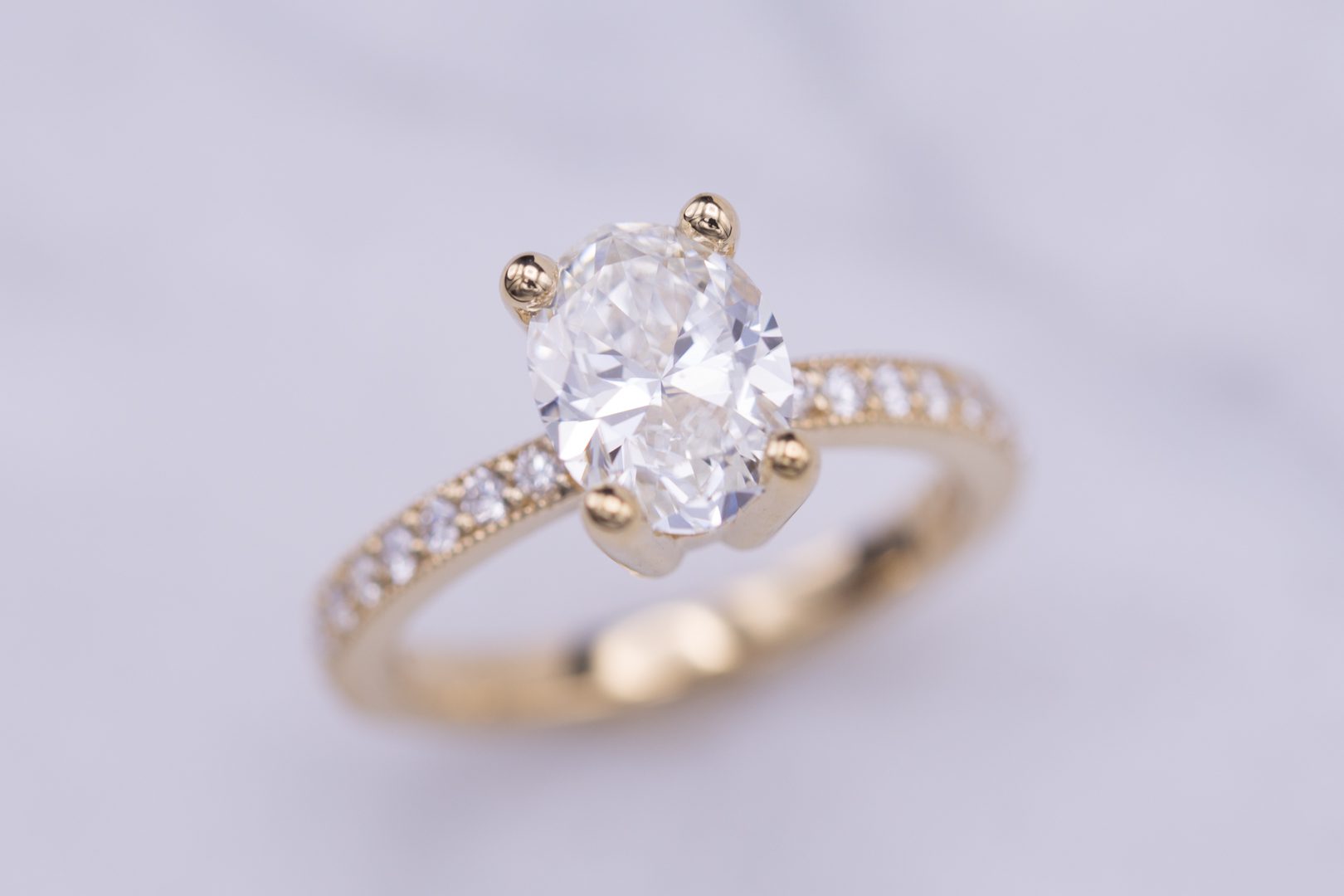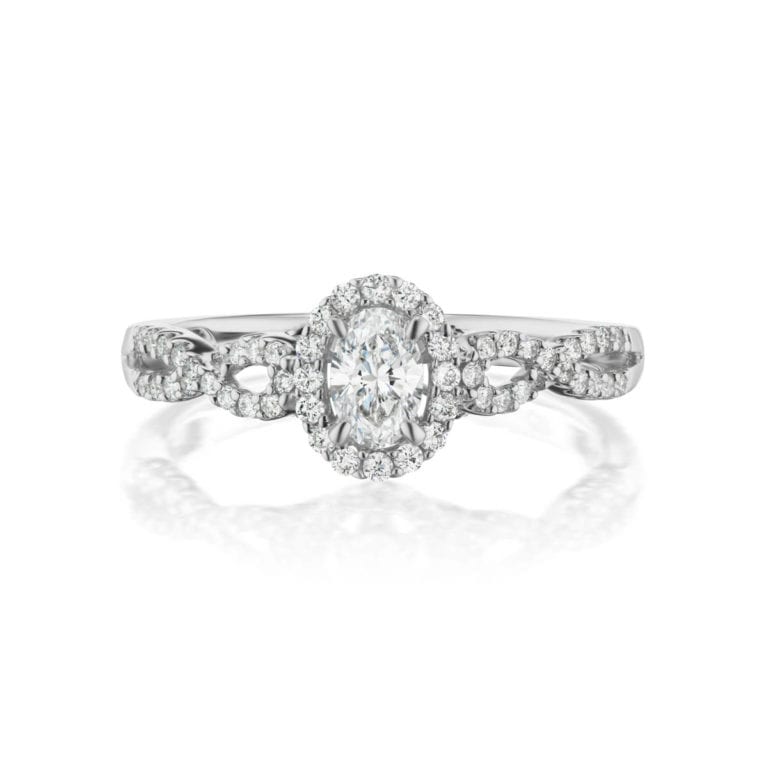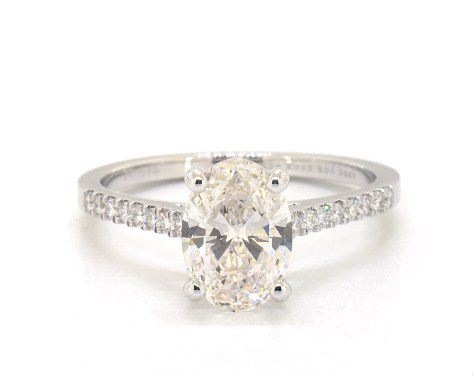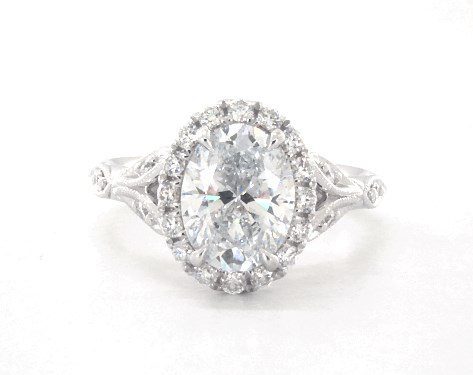Oval Cut Diamond Buying Guide
Don’t let the bowtie effect keep you from buying an oval cut diamond. With prices lower than rounds, ovals are also a stylish choice for engagement rings.
8 Minute Read
Nevertheless, you can still find a great-looking oval diamond. Learn the pros and cons of this shape and how to buy the best natural or lab grown oval-cut diamond for your budget.
at CustomMade
What is an Oval Cut Diamond?
Oval cut diamonds are aptly named for their elongated oval shape and are cut in the brilliant style. They have 58 facets, giving them more sparkle than most other fancy diamond cuts.
The Pros and Cons of an Oval Cut Diamond Ring
When choosing between an oval or round diamond, consider the following factors.
First — style! While oval cut diamonds may have a classic look, round brilliant diamonds are timeless. However, ovals and other fancy shapes have become trendy for engagement rings in recent years. When aligned with the finger, an oval shape has an attractive lengthening effect. On the other hand, East-West rings, with the oval aligned perpendicular to the finger, are gaining popularity and show off a unique style.
at James Allen
If you can go stylistically with either oval or round, then an oval cut diamond is well worth considering. The shape of the diamond directly impacts price and face-up size. This means that an oval cut can cost at least 25% less than a round cut of the same weight. Since the oval diamond has a larger surface, it will actually appear bigger than a round.
However, purchasing an oval cut diamond has one major downside. Round brilliants can be ideal, with nearly all the light entering a diamond reflecting back to your eye. Ovals just can't do this. Every oval cut diamond will show a bowtie across the middle — some prominent, some subtle.
Still, ovals can be one of the sparkliest diamond cuts on the market. Unfortunately, gemological laboratories don't grade oval diamonds. Fancy diamond cuts have so much variation that grades, especially for the cut, are more like judgments based on a stone's overall appeal. This will make your search more difficult. But that doesn't mean it's impossible. Here are our recommendations for finding your oval cut diamond — and staying within budget for your engagement ring.
Evaluating the Oval Cut
Although there's no laboratory grade for them, there are still well-cut and poorly-cut oval diamonds. Generally speaking, the best cuts offer more sparkle. There's no shortcut to figuring out which oval diamond will perform best. You'll simply have to look at them.
When searching online, limit the depth to 58-63% and the table to 53-63%. This will eliminate at least some of the stones with poor performance.
Shape
Ovals can come in many shapes. Avoid off-shaped ovals, with pointed or squared ends.
Similarly, look for symmetry in the overall shape of the oval. Egg shapes aren't desirable in an oval cut diamond. This differs from the symmetry in a laboratory report, which assesses facet symmetry.
Length-to-Width Ratio
You can also consider how elongated you'd like the oval. The length-to-width ratio (L/W) in an oval diamond is a matter of preference, but most prefer ratios between 1.3 and 1.5. For example, compare the shapes of the following three diamonds.
Oval Cuts and the Bowtie
All fancy shape diamonds have some light leakage. In oval cuts, a bowtie shape forms across the middle of the stone. While an oval cut diamond will always have a bowtie, not all bowties are alike. They can have differing degrees of prominence as well as effects on performance.
While some consumers consider a bowtie a fatal flaw, others may embrace this pattern in the middle of an oval cut. The best way to find an oval cut diamond you like is to simply look at them and find what you prefer. Do you like the aesthetic of a dark bowtie or a light one? Do you prefer a bowtie that's only noticeable at certain angles?
If you prefer to minimize the bowtie, you'll have to spend some time looking for one. There's no shortcut to finding these diamonds, but they do exist. Check out this 0.70-ct diamond.
Regardless of your preference, try for a diamond that shows sparkle throughout, even in the bowtie region. A diamond with a large dead area right in the middle isn't worth your money.
Oval Cut Diamond Clarity
Due to the high brilliance of this cut, imperfections in the diamond are usually difficult to see. A diamond with a clarity grade of VS2 or SI1 will most likely appear clean to the naked eye. SI2 stones may appear eye clean as well. Take care to avoid dark inclusions near the center of the diamond, since these are the most noticeable.
Oval Cut Diamond Color
While color plays a minimal role in round diamond quality, lower color grades in ovals stand out much more. For this reason, stick to color grades of H or better.
Keep in mind that color is more noticeable in larger diamonds. If you're looking at diamonds above 2 carats and the H color looks off, try an F or a G color.
That said, there may be I and even J color oval diamonds that face up white, but these may take some time and effort to find. Alternatively, off-color ovals can work well with vintage styles in yellow or rose gold.
Oval Cut Lab Grown Diamonds
Should I Buy an Oval Cut Lab Grown Diamond?
Lab grown diamonds are man-made diamonds. In fact, they have the exact chemical, physical and optical properties of natural diamonds. Basically, they can be manufactured faster in a laboratory than in the ground. What this means is that lab grown diamonds are available at a lower price to you and that value is hard to ignore when choosing a diamond.
at James Allen
at James Allen
How to Buy an Oval Cut Lab Grown Diamond
If you like the idea of saving money on your diamond combined with the ease of online shopping, popular online jewelers like James Allen, Blue Nile and With Clarity offer lab diamonds.
The online jewelry experience lets you educate yourself, search and compare diamonds and see images of the diamonds up close and personal. You can also see various diamonds in many different settings and set carat weight and/or budget parameters.
With lab diamonds, you can also enjoy knowing you are buying a high-quality, eco-friendly and ethical diamond at an affordable price.
at James Allen
at Blue Nile
Oval Cut Fancy Colored Diamonds
Fancy colored diamonds blend elegance and uniqueness in the world of gemstones. Unlike traditional white diamonds, these gems exhibit an array of hues, ranging from delicate pinks to intense and vibrant shades like green and purple. The popularity of fancy colored diamonds continues to grow and we love seeing new styles featuring these gems emerge.
The oval cut, with its elongated shape and brilliant faceting, adds a touch of sophistication to these colorful diamonds. This particular cut enhances the diamond's brilliance and fire, allowing the colors to dance in the light. The oval shape also creates the illusion of longer, more slender fingers when worn in a ring, making it a popular choice for those looking for both style and grace.
at CustomMade
Online retailers like James Allen, Blue Nile and CustomMade make finding fancy colored diamond rings easier than ever.
Oval Cut Summary
- 1. Oval cuts can show a dark area commonly known as a bowtie.
- 2. If you are looking at an oval or round, an oval cut can cost at least 25% less than a round cut of the same weight.
- 3. Avoid off-shaped ovals with pointed or squared ends because they can chip.
Where To Buy an Oval Cut Diamond Ring
Purchasing an oval cut diamond online is time and budget efficient. Just be sure to use a reputable dealer and remember to look at their policies on returns, exchanges, and resizing.
Because no laboratory grades exist to assess cut quality in ovals, you absolutely must look at your diamond in 360°. Both Blue Nile and James Allen make it possible for you to view your diamond online in this manner, giving you an informed idea of the diamond's performance and the bowtie effect.
While both have extensive databases of diamonds, James Allen has many more options for ring settings. Furthermore, James Allen allows you to see ring and diamond combinations that others have purchased. This will help you get a better idea of the finished engagement ring.
However, Blue Nile has one advantage over James Allen for oval cut diamonds. Blue Nile's search allows you to limit the L/W ratio. If you're picky about the shape or replacing a stone for an old setting, Blue Nile might be a better option.
If searching for the perfect oval cut diamond frustrates you, consider working with the jewelers at CustomMade. With their expert help, you'll be able to find the diamond that's best for you and place it in a custom engagement ring you'll cherish.
at CustomMade
FAQ
1. Are oval cut diamonds more expensive?
Oval cut diamonds can cost 25% less than a round-cut diamond of the same carat weight, making them a much more budget-friendly choice. Oval cut diamonds also have a slightly larger face-up surface, so they will look even bigger than a round-cut diamond of the same carat weight.
2. Is oval a good cut diamond?
Oval cut diamonds are a great choice if you are looking for an elongated diamond shape with lots of sparkle. Their shape makes them look even larger than a round cut diamond of the same carat weight and can have a slimming effect on the finger of the wearer, further adding to their appeal. Oval cuts do exhibit the "bowtie" effect, a dark area across the center of the stone where light is not reflected. Some buyers prefer to avoid the bowtie, but a high-quality oval cut diamond can minimize the bowtie.
3. Which is better oval or round diamond?
Oval cut diamonds are a great choice if you like the smooth, rounded shape of a round-cut diamond but want a larger gem on a tighter budget. Round brilliant cut diamonds exhibit more brilliance and perform better than oval cuts, reflecting more light back to the viewer. Because of this, round-cut diamonds may be a better choice if you have a larger budget and are not set on the oval shape.
4. Why is oval cut cheaper than round?
Round brilliant cut diamonds are the most sought-after diamond shape, so their high price reflects their popularity. Oval cut diamonds can be 10-30% cheaper than rounds because they are less popular and do not perform as well, but their large size and distinctive shape make them an excellent budget-friendly choice.
Addison Rice
A geologist, environmental engineer and Caltech graduate, Addison’s interest in the mesmerizing and beautiful results of earth’s geological processes began in her elementary school’s environmental club. When she isn’t writing about gems and minerals, Addison spends winters studying ancient climates in Iceland and summers hiking the Colorado Rockies.
Related Articles
Diamond Value, Price, and Jewelry Information
Diamond Rough and Equipment for the Occasional Diamond Cutter
Diamond Cutting for Hobbyists: Getting Started
Are Diamonds Really Rare? Diamond Myths and Misconceptions
Latest Articles
800 Years of Mogok: A Celebration in Tenuous Times
What is the Average Gemstone Faceting Yield?
Pyroxmangite Value, Price, and Jewelry Information
How to Identify Emerald Simulants and Synthetics
Never Stop Learning
When you join the IGS community, you get trusted diamond & gemstone information when you need it.
Get Gemology Insights
Get started with the International Gem Society’s free guide to gemstone identification. Join our weekly newsletter & get a free copy of the Gem ID Checklist!



